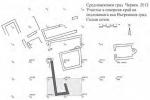Summary (English)
CHERVEN (Stoyan Iordanov – stojan_jo@abv.bg) A cemetery and a quarter with houses and workshops existed in the Northern Sector of the saddle in the Inner Town. The explorations of the building c. 10 m by 3 m in size, located close to the Central Sector, continued. Its walls were 70 cm wide, constructed in rubble masonry. The surface stratum was as much as 40 cm deep, containing sherds of the 13th – 16th centuries, coins of the 14th century, knives, nails, iron slag, arrowheads and slingshots, which had slid down the slope. The lower stratum was 30 – 50 cm thick and contained debris from the building, sherds of the Second Bulgarian Kingdom (12th – 14th centuries) and the Early Ottoman period (15th – 16th centuries), 20 copper coins (including from the Bulgarian King Ivan Alexander, Ivan Alexander with his wife Theodora of Walachia, Ivan Alexander with his son Michael Asen IV, the Bulgarian King Ivan Shishman, Bulgarian imitative coins of the second half of the 14th century, one coin of the Bulgarian King Kaloyan or the Byzantine Emperor Manuel I Komnenos, one coin of the Despot John II Orsini and one coin of Theodosius II), copper spherical buttons, appliqués, an earring, a finger-ring, a belt buckle, fragments from glass bracelets, a small bronze cross, part of a small goldsmith hammer, a chisel, a pair of scissors, knives, scrap from copper sheet, copper melts, glass melts, iron nails, clamps, rings, animal bones from boars, pigs, ox, birds and fishes. The building was a jewelry workshop. This identification is confirmed by the mould for production of jewelry that was found in 2012. Judging from the coins that were discovered, the workshop functioned actively during the second half of the 14th century.
- Stoyan Iordanov - Regional Museum of History – Ruse
Director
Team
Research Body
- Regional Museum of History – Ruse






![Download [PDF]](/excavation/skins/fasti/images/results/download_sml.png)
